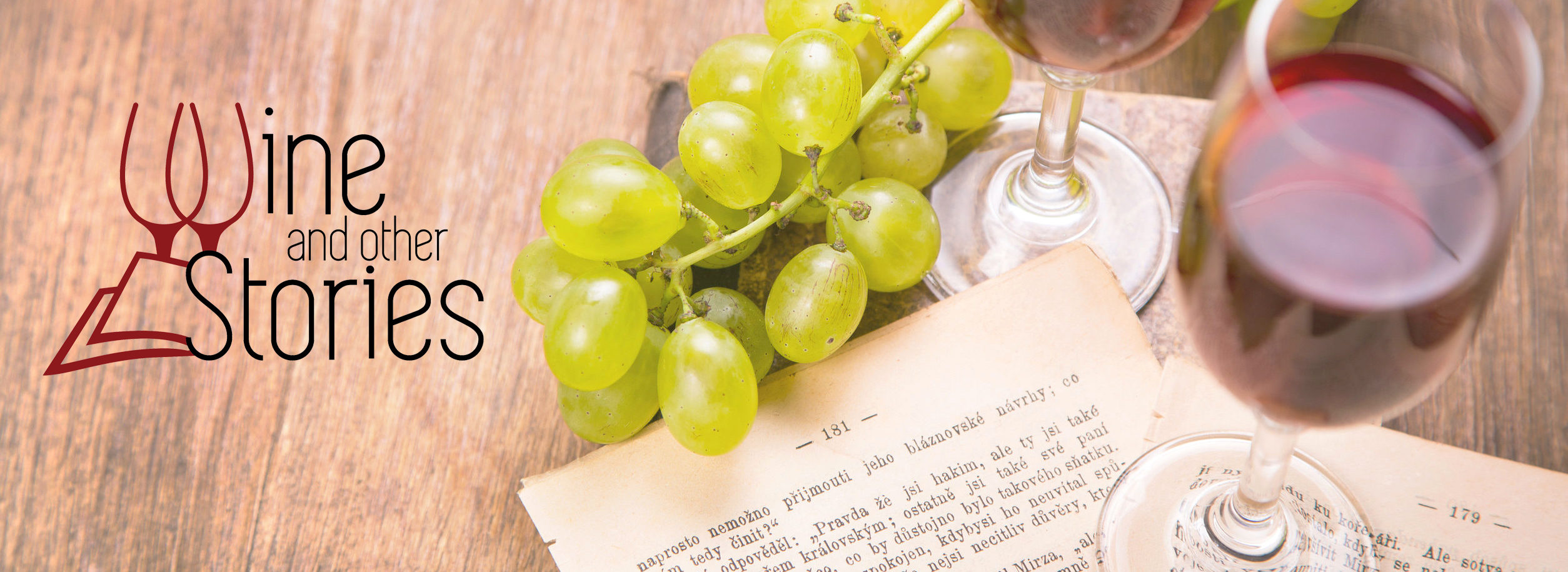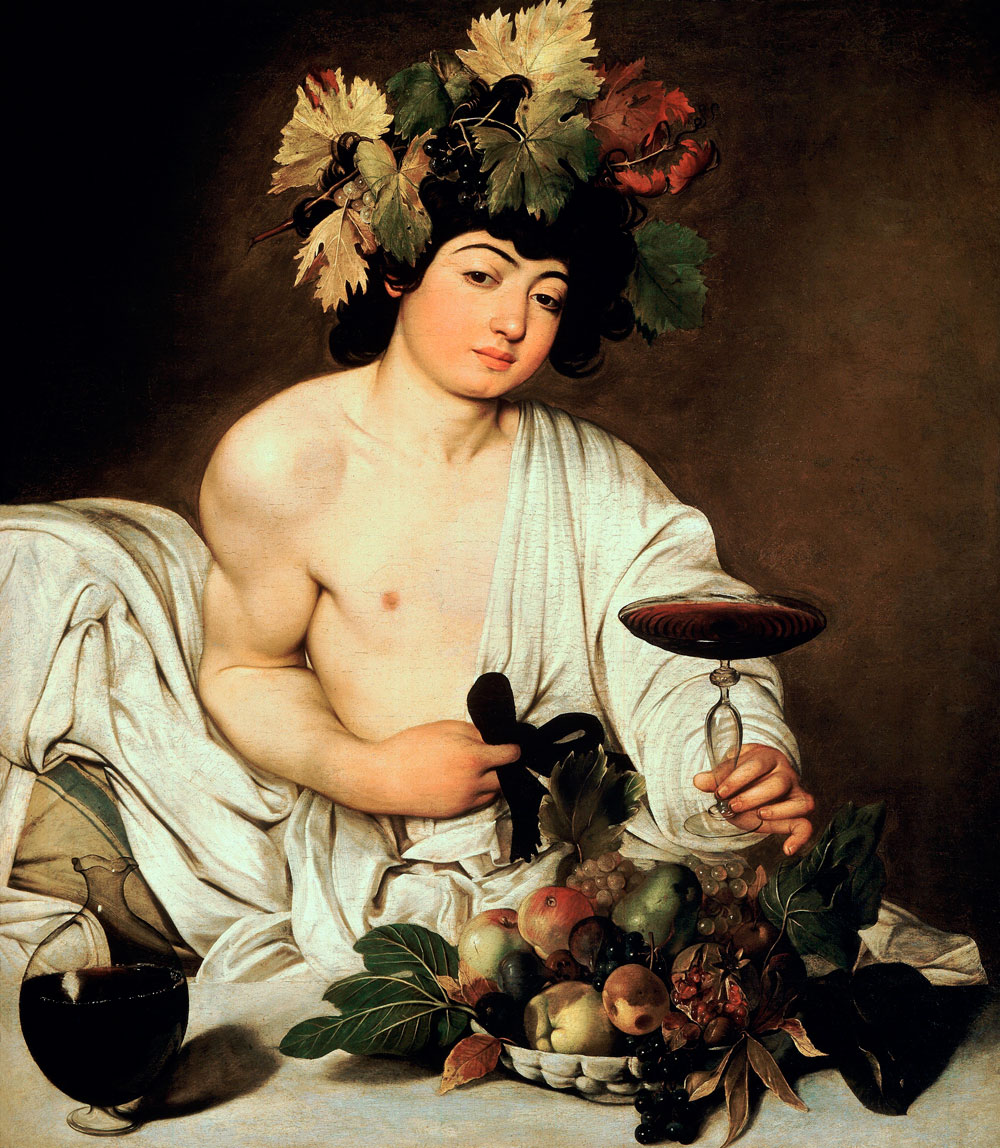The famous painting by Caravaggio – the Bacchus – depicts a young boy with wine. Is he offering that wine to us – the viewer? Most importantly, which wine could it be? I have a couple of guesses…
Once upon a time there was a curious child that liked to run at breakneck speed through the corridors and rooms of an old house. Occasionally, the child would stop at the door of the living room transfixed by a painting hung there.
The painting was of a young man bare but for a simple robe draped over his left shoulder. Muscular, with a relaxed and engaging expression upon his face. Holding a glass of ruby-coloured wine, the man almost seemed to stare at the kid with an attitude in between seduction and generosity, grace and satisfaction.
That child was me, more or less thirty years ago. The painting, an almost perfect replica of one of the most important masterpieces created by Michelangelo Merisi, aka Caravaggio. I’m talking about the Bacchus, a painting that fascinates me as much today as it did three decades ago.
The painting
Dating from around 1595, the Bacchus is currently held in the Uffizi Gallery, Florence. It was commissioned by Cardinal del Monte the year after Caravaggio entered his court, during his prolific Roman period.
The Bacchus was Caravaggio’s first classically inspired portrait. The youthful man, in a subtle sexualised pose, lays on a Roman couch dressed in simple drapery. His hair crowned with a wreath of grapes and leaves. With his left hand he offers the viewer a wide goblet of red wine. The liquid’s surface still rippling from his movement. The man’s right hand casually plays with his sash, which loosely holds his drapery together. In front of the man lies a basket of ripe fruit and a large carafe of wine – the same wine he offers in the goblet?

Caravaggio – the master of chiaroscuro
The Bacchus embodies all the major traits of Caravaggio’s style. The dramatic use of light is a constant feature of Caravaggio’s works. The light is intense, the shade emphatic, creating spectacular and vivid contrasts (chiaroscuro). Another feature of Caravaggio was how he combined the sacred and mundane. He would often portray holy figures with humble and ordinary features. Here Bacchus, the ancient and revered god of Greek mythology, is presented as an everyday young man. He could be Christ at the Last Supper or a simple Roman citizen. Or perhaps a young commoner working in the countryside (as revealed by the dirt under his fingernails and the tanned skin of his face and neck).
Whatever the interpretation of the Bacchus, his figure expresses great physicality. The young man is muscular but not too burly. He poses in a comfortable way, his chest brightly lit. His neck is slightly reclined. His facial expression tranquil, indulgent, almost sullen, yet provocative.
The focus on physicality in Caravaggio’s art was a characteristic of his realism. Throughout his life and works the artist refused idealisation and tried to be faithful to the observed reality as much as he could.
The attention to detail in the Bacchus is stunning. It’s present in the aforementioned dirty fingernails. In the overripe fruit basket which seems so real you want to touch it. Moreover it exists in the reflection of the man in the glass carafe. Some say the reflection is a micro self-portrait of Caravaggio himself! Last, but not least, are the details painted into the glass of red wine. The ripples on its surface. The tiny barely noticeable bubbles which suggest the wine has just being poured as an offering to the viewer.

Possible interpretations
Christians view wine as a symbol of the Passion (the final period of Jesus’ life and resurrection). Therefore the young man’s gesture could represent the offer of Christ’s blood to mankind. Another possible interpretation is more naturalistic and takes symbolic meaning from the images of the wine glass, the vine crown and the basket of ripe fruit. According to this explanation, the wine represents a gift by Nature, which in its eternal cycle evolves over time and eventually decays. The fruit in the basket is actually overripe, verging towards rotten.
One more intriguing (and utterly personal) interpretation arises from the observation of certain familiar details: the relaxed expression of the man, the slightly dilated nostrils; the fingers holding the glass from its stem (so that the hand won’t contribute to its odour); the ripples on the wine surface that suggest the young man has just swirled the glass. For me, he is a young wine taster, ready to savour the divine nectar contained in his fancy cup!
Since I like to unleash my imagination for vinous matters, I tried to figure out what kind of wine the young Bacchus might hold in his goblet. Of course, it has to be a red. A young wine – to reflect the youth of its holder. However, even a young Bacchus would know a good wine. So, the wine should be genuine in its craftsmanship, refined but not too sophisticated.

The wines of the Bacchus
I chose two wines.
One is from the newly formed Roma DOC. I find it apt as Caravaggio’s Bacchus was painted in Rome, where the artist spent fifteen years – the most prolific and successful period of his tormented career.
For the second wine, we travel to Lombardia, where Caravaggio was born. The second red is from the region of Valtenesi, which is some kilometres west of Bergamo (near where Caravaggio’s parents lived), along the shores of the Garda Lake, close to the Veneto border.
Poggio Le Volpi - Roma Rosso, 2015

 Country: Italy
Region/appellation: Lazio - Roma DOC
Wine style: Dry red - Rich and intense
Grape(s): Montepulciano, Syrah, Cesanese
Average price: £16
Country: Italy
Region/appellation: Lazio - Roma DOC
Wine style: Dry red - Rich and intense
Grape(s): Montepulciano, Syrah, Cesanese
Average price: £16
Poggio Le Volpi winery is located in Monte Porzio Catone, a small town a few kilometres south-east of Rome. The company dates back to the 1920s, when the original owner Manlio Mergè started planting olive trees and vines in this volcanic area. Today, the vineyards extend for 30 acres, starting from Monte Porzio Catone and proceeding southwards into the rich Roman countryside.
Poggio Le Volpi focus on wines labeled as Roma DOC. This new appellation, founded in 2011, covers both whites and reds. The whites from Roma DOC are made from local grape varieties such as the perfumed Malvasia Puntinata, Malvasia Bianca di Candia and other italian white grapes. While the reds are made from at least 50% montepulciano grape, blended with both local and international grape varieties.
Tasting notes
(tasted on: 26-Mar-2019)
The wine appears dark ruby in the glass. From the start, the nose expresses a pronounced intensity. The aromas are rich, warm and inviting. Raspberry compote, macerated red and black cherry, ripe red plum mingle with sweet suggestions of clove, cinnamon and a touch of potpourri. A gentle toastiness alternates with intense spiciness. When the wine opens up, notes of liquorice, earth and luscious chocolate can also be perceived.
In the mouth this wine is full in body, broody and succulent. Red and black macerated fruit intermix with clove, chocolate, toast, coffee powder. The tannins are high in level, but ripe, fleshy and dense.
Its medium acidity reveals an ample and broad feeling, intense in flavours and succulent in nature. The finish is persistent and almost sweet.
Wine and other Stories rating: 8.9/10
Ca' Maiol - Negresco, 2016

 Country: Italy
Region/appellation: Lombardia - Valtenesi DOC
Wine style: Dry red - Savoury and classic
Grape(s): Groppello, Barbera, Sangiovese, Marzemino
Average price: £20
Country: Italy
Region/appellation: Lombardia - Valtenesi DOC
Wine style: Dry red - Savoury and classic
Grape(s): Groppello, Barbera, Sangiovese, Marzemino
Average price: £20
Ca’ Maiol Estate was established in 1967 by Walter Contato, who was also responsible for the creation of the Consorzio Lugana.
The story of Cà Maiol has actually always been linked to the Lugana appellation.
Lugana lies next to the relativly small Valtenesi DOC appellation. Both appellations sit on the shores of the Garda Lake. Valtenesi DOC is famous for its rosé and red wines which are based on a local grape called Groppello.
This wine is named after the notorious “Le Negresco” Hotel situated in Nice on the French Riviera.
The fruit is sourced from the Valtènesi’s top-quality vineyards where grapes such as groppello, marzemino, sangiovese and barbera are grown. After a long fermentation on the skins, the wine is aged for about 18 months in 225-litre French oak barriques.
Tasting notes
(tasted on: 07-Apr-2019)
The wine displays a perfect ruby hue, with medium intensity. To the nose, it opens up with succulent and juicy red fruit: red cherry, plums and raspberry. The wine exudes elegance, refinement and a decent complexity. Nuances of toast, wicker basket, earth, nutmeg, red spices, bread crust and tobacco leaves chase each other in the glass, contributing to a lovely aromatic profile.
To the palate, the wine presents perfect ripeness of fruit. Medium to full in body, it has a juicy and defined character. The aromas mirror the nose, but with the additions of liquorice and dried herbs. Good concentration of flavours, combine with elegance and focus. A perfect acidity balances the richness of aromas. The tannins are medium+ in level, smooth and refined. The finish is long and aromatic, with a touch of sweet baking spices in the aftertaste.
Wine and other Stories rating: 9.0/10

